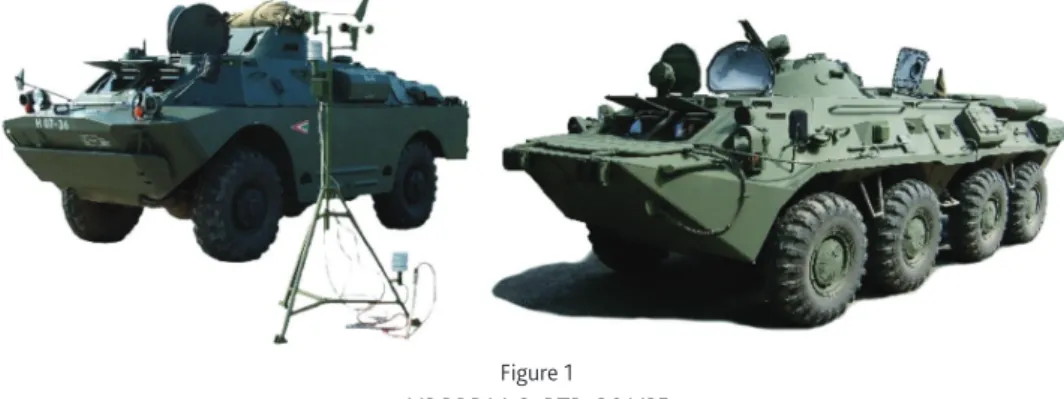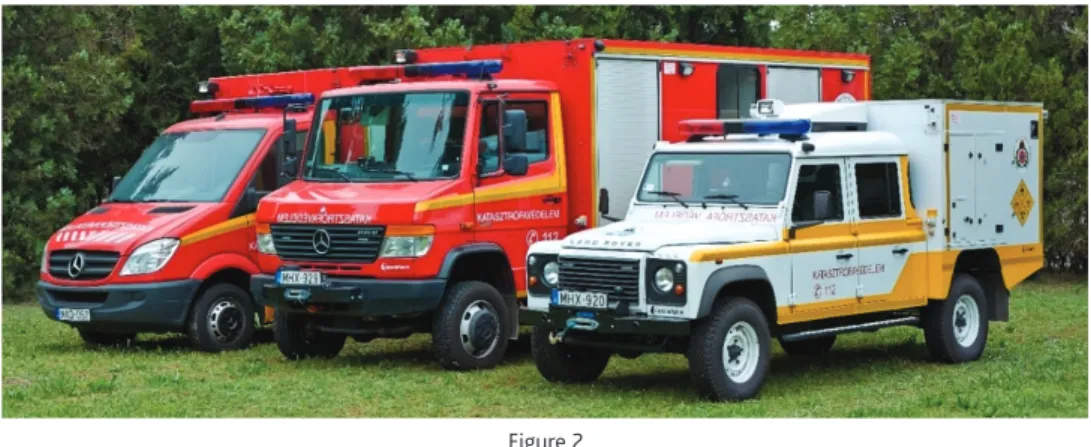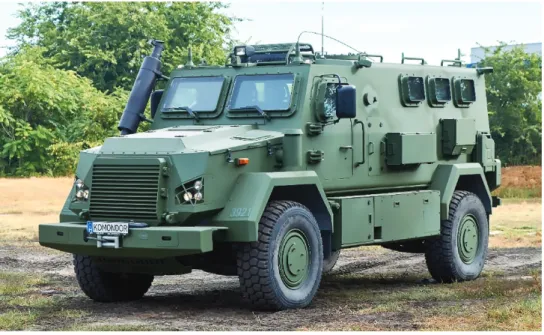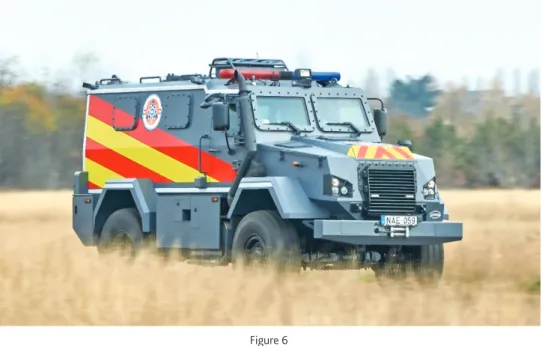HADMÉRNÖK
DOI: 10.32567/hm.2021.4.4 HADITECHNIKAAttila Zsitnyányi
1�Development of Hungarian Light Armoured Vehicles for Disaster Management and Military Applications
When launching the Zrínyi 2026 program, the Hungarian Government set the goal of taking into consideration the opportunities for the development of the Hungarian defence industry with regards to procurements, and in connection with this, the Irinyi plan defined the defence industry as one of the national strategic industries.
This, of course, requires domestic products, such as the Komondor2 light armoured vehicle family developed in Hungary. The study depicts the main vehicle and model variants through the development process.
Keywords: Hungarian defence industry, armoured vehicle R&D, RDO, Komondor, disaster management
1. Introduction
International practice shows as an example to follow that in the performance of national defence tasks, within the framework of allied obligations, countries try to rely primarily on their own industries. But in Hungary after the change of regime, the loss of external and internal markets caused a functional and structural crisis in the military industry. The research and development background related to the sector in a narrower and broader sense has also suffered a serious decline.
The Zrínyi 2026 program can present new opportunities. An important factor in the developments is the government’s consideration of the widest possible, well- thought-out revival of the domestic defence industry.
All countries with a vehicle industry have developed their light armoured vehi- cles adapted to modern forms of warfare, thus developing, further developing and
1 University of Public Service Doctoral School of Military Engineering, PhD student, e-mail: zsitnyanyi@gamma- tech.hu
2 Komondor is a Hungarian breed of livestock guardian dog; it is a large, white-coloured breed with a long, corded coat.
maintaining their own national industries. Accordingly, the design and production of the Komondor combat vehicle family will have an impact on other companies, also operating in the defence industry, and other related industries.
This study presents the historical stages of the development. It summarises the main features and capabilities of the Komondor base vehicles and model variants implemented so far.
2. Historical antecedents of the development process
2 1 Antecedents of military vehicle production in Hungary after World War II
At the beginning of the sixties, the improvement of the armour protection of the infantry units was planned in the Hungarian People’s Army. The decision on the development of the Hungarian reconnaissance amphibious vehicle was made in 1960, the design process started in 1961 based on the plans of the Ministry of Defence, Institute of Military Technology (HM HTI).The goal was to create a vehicle that would enable the detection of opposing forces and radiation contamination even in enemy territory. For this purpose, an amphib- ious, armoured vehicle was designed on the basis of the Hungarian D-344 Csepel off-road truck. The D-442 reconnaissance amphibious vehicle was brought into the system in 1963, the production was carried out by the Hungarian Railway Carriage and Machine Works Plc in Győr (Rába) between 1963 and 1968. A total number of 2,300 vehicles (the commercial name is FUG) were produced, of which 1,574 pieces were delivered to Czechoslovakia and Poland.3
Based on the FUG, the D-944 armoured personnel carrier vehicle, or PSZH4 in its Hungarian abbreviated form, was developed. Rába started the serial production of the D-944 PSZH in 1970, 2,848 pieces were produced by the termination of its manufacturing in 1980.5
2 2 Why was the development started, where did the idea come from?
The supply of chemical protection and nuclear measuring instruments to the Hungarian defence forces (HDF) is one of the fields of expertise that has been con- tinuously achieved through domestic development and production, as a result of decades of cooperation between Gamma Műszaki Zrt. (hereinafter: Gamma) and the HM HTI. Gamma (founded in 1920), as a profile owner, has been a key supplier
3 Ferenc Hajdú and Gyula Sárhidai, A Magyar Királyi Honvéd Haditechnikai Intézettől a HM Technológiai Hivatalig 1920–2005 [From the Royal Hungarian Army Institute of Military Technology to the HM Technology Office 1920–2005] (Budapest: HM Technológiai Hivatal, 2005).
4 PSZH armoured personnel carrier, in Hungarian páncélozott szállító harcjármű.
5 Hadtörténeti Intézet és Múzeum, Fegyverzet és hadfelszerelés [Armament and military equipment].
of HDF CBRN6 reconnaissance vehicle developments since the 1950s. Following the change of regime, the modernisation of the VS7 BRDM vehicles was started in 2001, for which Gamma developed an onboard CBRN reconnaissance system.
In 2007, this system was further developed on the basis of BTR-80 (as BTR- 80 VSF8). Subsequently, there were constant requests from abroad to supply a complex CBRN reconnaissance vehicle, when they realised that in the absence of a domestically manufactured vehicle, they could not provide a competitive offer.
This highlighted a very important problem of the Hungarian defence industry;
namely, if there is no carrier device, then the chances of selling vehicle-mountable systems are minimal.
Figure 1 VS BRDM-2, BTR-80 VSF Source: Gammatech, Gamma Company Profile.
2 3 Development of disaster management capabilities
In 2007, the company also began to develop in other areas related to vehicle man- ufacturing. As a result, the Disaster Management Mobile Laboratory (KML9) devel- oped by Gamma and its reduced capability versions (KML ADR) appeared in the application of BM OKF.10 They are capable of emergency assessment, radiation and chemical detection, decontamination, and they also function as a mobile office when performing roadside checks.
6 CBRN: Chemical, Biological, Radiological and Nuclear.
7 VS – NBC: Nuclear Biological Chemical.
8 VSF – NBC reconnaissance.
9 KML: Hungarian abbreviation of Disaster Management Mobile Laboratory.
10 BM OKF: Hungarian name of National Directorate General for Disaster Management, Ministry of the Interior.
Figure 2 KML, KML ADR vehicles
Source: Gammatech, Gamma Company Profile.
In 2010, as one of the leading companies in the Hungarian defence industry, Gamma launched Hungary’s first independent light armoured vehicle development project. Dur- ing the past years, the expansion of the vehicle family, the modernisation of the existing vehicles, the installation of new solutions and, of course, the design and construction of new versions to satisfy the emerging customer needs have been ongoing. In this article, in addition to describing the development process, I focus on the technical details of the implemented vehicles, and I present the additional possibilities inherent in the vehicle family.
3. Main steps in the development of light armoured vehicles
3 1 The beginnings
In 2010, Gamma started to develop the concept of a complete light armoured com- bat vehicle family and its possible model variants. The aim of the development was to create a base vehicle family that meets the application principles of NATO and satisfies the needs of the users and operators of the Hungarian Defence Forces, with sufficient protection, firepower, agility, survival, etc. and, as a result of its design, is suitable, or can be made suitable for any special tasks.
3 2 The RDO-3221 Komondor
The first base vehicle version of the vehicle family with type identifier RDO-322111 was manufactured during the implementation of the project awarded in state scheme
11 In the numbering of vehicles, “RDO” is the name referring to the manufacturer (abbreviation for “Respirator Design Office” refers to the Respirator company, which started the development and merged into Gamma Műszaki Zrt.
in 2015). The first two digits of the number combination refer to the wheelbase, followed by the number of axes, followed by the design ID. (Based on these, 3221 is interpreted as 3200 mm wheelbase, 2 axles and a closed body.)
“Encouraging Corporate Innovation (KMOP 1.1.4-09)” announced by the National Development Agency (NFÜ) in November 2010. As the traditional profile of Gamma, the main focus was on presenting the NBC reconnaissance capability that can be integrated into a vehicle. However, the basic technical solutions that characterise the whole vehicle family have also appeared, a welded self-supporting armour body that also standardises the external appearance, with a ‘V’ shape lower part running along the entire length of the vehicle.12
An Iveco Tector 279 diesel engine was installed in the body manufactured by Gamma. The undercarriages are rigid, wheel-reduced, semi-elliptical leaf-suspension, with hydraulic shock absorbers. Both axles have electronically controlled, pneumati- cally activated cross differential locks. Depending on the primary infantry character, the design can accommodate a staff of 2 + 7 persons.
As a result of the development, in addition to the base vehicle, the first type variant was the RDO-3221 CBRN.13 The vehicle’s equipment and on-board detection system (chemical, radiation and biological detectors, sampling and collective protection devices) are built based on the most advanced technical solutions available.
Figure 3
RDO-3221 CBRN with add-on armour Source: RDO Komondor.
12 Gammatech, Gamma Komondor MRAP.
13 Miklós Kovácsházy, ‘Az RDO Komondor többcélú páncélvédett járműcsalád I. rész’, Haditechnika 49, no 4 (2015), 50–53.
The construction of one of the most complex type variants (CBRN) proved that practically any other capability suitable to be placed in the useful space given, may also be implemented in the base vehicle (e.g. gunnery, reconnaissance, ambulance, anti-tank missile, technical recovery, law enforcement vehicles).
3 3 The second generation vehicles
Following the successful implementation of the RDO-3221, a new chapter in the development of the vehicle family has started. The capabilities have already been designed in accordance with the specific requirements defined by potential users, some elements of the transmission system have changed. The previous rigid suspen- sion has been changed to an independent suspension and the manual transmission has been replaced by an automatic one. Based on these new principles, the devel- opment of the RDO-3921, intended to be the successor of the RDO-3221, and also its big brother, the RDO-3932 with a 6 x 6 wheel formula, was started with the aid of a scheme announced by the New Széchenyi Plan, Research and Technological Innovation Fund in 2012.
3 4 The RDO-3921 Komondor
The second version of the vehicle family was a 4 x 4 version, permanent all-wheel drive with independent suspension system. It is powered by a Cummins ISLe diesel engine with a maximum output of 340 hp. Developed specifically for heavy trucks and military purposes, this engine drives nearly 70% of similar LAV14 vehicles. The propulsion delivered by the vehicle’s engine is transmitted to the transfer case via an Allison 3200 SP six-speed automatic transmission.
The vehicle’s drive axles come from a special military ISAS 4000 series made by the U.S.-based AxleTech company’s factory in France. An equipment of the Hungar- ian company Silex, which manufactures several modules of the vehicle’s electronic system, can pre-program the air pressure values for different road conditions and load levels, even to different degrees for each wheel.
According to the relevant standard (NATO STANAG 456915) classification, the composite armour solution, implemented on a prototype vehicle and tested in shot tests, provides level 2 ballistic protection as standard. During the ballistic tests, several composite solutions have been developed (ceramic, armour plate, internal cover) so that the ballistic protection of the vehicles can be increased up to level 4. Based on the performed simulations and tests, the vehicle’s self-supporting body, which protects both the engine and crew compartments, the ‘V’ shape armour, the technical solutions and special safety elements applied in the interior, successfully protect the crew at protection level 3a/3b in case of explosion.
14 LAV: Light Armoured Vehicle.
15 NATO STANAG 4569: Protection Levels for Occupants of Armoured Vehicles.
Figure 4 RDO-3921 Source: RDO Komondor.
To demonstrate the variability of the RDO-3921 base vehicle, the prototype was developed in two model variants. The basic 2 + 8 person transport version can be converted into a casualty transport vehicle – suitable for 3 + 2 inpatients or 6 seated casualties – by the operating staff in a short time.
3 5 The RDO-3932 Komondor
A 6 x 6 all-wheel drive, half armoured body version of the vehicle family. Due to its design and good off-road capability, depending on the replacement superstructure used, it can be utilised for many different purposes, from ambulance, C2, technical recovery, CBRN reconnaissance, minesweeper or logistic vehicle.
Considering the family principle in the applied technical solutions, it is almost exactly identical with the RDO-3921 4 x 4 base vehicle, the only differences are in the parameters of the individual components and in the three-axle design.
Higher vehicle weights require a more powerful powertrain. Accordingly, the Cummins 6-cylinder engine, which is identical in design with the smaller version, delivers 450 hp and 1640 Nm of torque to the more robust 4000 Series Allison automatic transmission, thanks to a different charging system. In order to meet the hydraulic energy requirements of the superstructure, a stationary hydraulic pump that can be connected to the transfer case has been installed.
Figure 5 RDO-3932 Source: RDO Komondor.
The RDO-3932 prototype is suitable for transporting 2 + 3 persons in a half armoured, double cabin design; of course, this version can also be made with a fully enclosed armoured body. In this case, in addition to the current dimensions, it can be used to transport 2 + 12 persons and their equipment. In order to demonstrate the possibili- ties, a technical recovery superstructure was developed for the completed prototype vehicle. This assembly can be easily dismantled and replaced with other replacement superstructures, ensuring targeted multifunctional applicability.
3 6 The first sale
The first sale took place in 2015. As the winner of a public procurement procedure, Gamma entered into a contract with MVM Paksi Atomerőmű Zrt. (MVM Paks Nuc- lear Power Plant Ltd.) for the supply of a “radiation-shielded vehicle”. The company had not yet had a vehicle that fully complied with the tender requirements, so it was a perfect opportunity to present the possibilities of the vehicle, to prove the company’s capabilities as well as the viability of the domestic implementation of a vehicle of such complexity.
A vehicle suitable for satisfying the special needs specified by the Accident Pre- vention Department of MVM Paks Nuclear Power Plant Ltd. was developed on the basis of the RDO-3221 vehicle. The vehicle is simultaneously equipped with radiation shielding, a certain level of physical protection and off-road capability, and a radia- tion protection monitoring system. In order to achieve the required attenuation of gamma radiation, the body had to be thickened at several points; special glass, pro- viding radiation protection was installed and the driver and staff compartments were separated. With the decontamination possibilities in mind, the interiors were given
a flexible polyurethane cover. In addition to the filtering (ventilation) system, which also provides the required overpressure, based on the requirements of the tender, an individually developed radiation measuring and alarm system (by Gamma) has also been integrated into the vehicle.
Figure 6 RDO-3221 RSV Source: RDO Komondor.
3 7 The RDO-3121 Komondor
During the development and testing of the existing model variants, the need arose to create a vehicle that is smaller in size but has greater protection even without the use of composite systems. In its appearance, equipment and basic construction, the RDO-3121 follows the family principle; it is the smallest member, is nearly a meter shorter, and it is also significantly lower compared to its counterparts. Its interior provides the possibility to transport 2 + 3 persons, to create workplaces and there is enough space left for the integration of special systems, for transporting load. The 6.7-liter Cummins engine built into the vehicle, due to its lower environmental rating, is capable of 364 hp at 1,100 Nm of torque. Due to the lower torque, the vehicle has been given a different gearbox (ZF VG 750), which, however, has a three-speed, switchable longitudinal differential lock, similar to its predecessors. The armour of the RDO-3121 prototype provides a higher level of ballistic protection as standard (STANAG 4569 level 3).
Figure 7 RDO-3121 Source: RDO Komondor.
Like the other members of the vehicle family, the prototype vehicle can be manufa- ctured in different sizes, equipment and interior layout.
4. Development of new versions for disaster management (also) purposes
4 1 Historical background
In previous developments, the company has emphasised that the prototypes are basically used to showcase the capabilities of the vehicle family, and are ready to
“make” it based on any domestic or foreign needs. In 2018, the time for proof came, an international tender was launched for the supply of S3 category, double cab, mul- ti-purpose vehicles (where the previously developed Komondor versions did not meet the technical requirements set by the tender). Gamma, as the winner of the public procurement procedure, delivered three double-cab, multi-purpose vehicles to BM OKF.
The RDO-4336 vehicles, which were launched in the summer of 2020 and have special interchangeable superstructures, are based on a new version of the base vehicle with the RDO-4332 type identifier which was developed within 1 year due to the contract.
4 2 The RDO-4336 Komondor
The multi-purpose, double-cab base vehicle with interchangeable superstructure carries the characteristics of the vehicle family, but due to its intact uniqueness, it also
shows many differences in the technical solutions. The vehicle has a self-supporting armour body, which ensures its applicability even when approaching focal points where there is a risk of explosion and consequently the possibility of fragmentation. The base vehicle is capable of carrying 2 + 4 persons under difficult terrain conditions with a large amount of water and/or equipment. In order to meet the applicability requi- rements, the base vehicle is fitted with integrated fire extinguishing elements, a front adapter to accommodate a worktop, hydraulic power supply systems, a quick-acting extinguishing device and its accessories.
To meet the requirements, this variant is powered by the 500 hp 2300 Nm Euro5 environmental rated 12-liter Cummins engine, the first ones implemented in vehicles in Europe. AxleTech ISAS 4500 undercarriages were fitted to the vehicles, which were different from the previous ones, with a stronger load-bearing capacity, but also with an independent suspension solution.
The vehicle consists of three separate units, the base vehicle, the water trans- porter/forest firefighting superstructure and the technical recovery superstructure.
BM Heros Zrt. carried out the firefighting design of the vehicle and the con- struction of the water transporter/forest firefighting superstructure. The bodywork includes a 7,000 litre water tank and a fire extinguishing pump capable of foam mixing as well, which supplies the remote-controlled front nozzles, the emergency extinguishing and self-defence systems with low or, if necessary, high-pressure extinguishing agent. It provides an opportunity to apply water to operational areas that are difficult to access from a road supply point or are inaccessible by road vehicles. The vehicle is also suitable for carrying out professional tasks standard for conventional fire trucks.
The technical recovery superstructure provides the ability to intervene through integrated hydraulic systems (11 tm self-loading hydraulic crane, fork-lift truck) and loaded technical rescue equipment (hydraulic cutting/tensioning, support, lifting equipment, aggregator, tools, etc.) which are especially useful in the event of exten- sive road accidents.
Figure 8
RDO-4336, with different superstructures Source: RDO Komondor.
The RDO-4336 Komondor vehicle-based professional capability can be expanded by additional individual superstructures if required.
5. The future
The development of the vehicle family will not stop with the fulfilment of the cont- ract either. On the basis of the existing base vehicles, additional model variants, superstructures and accessories will be made by the 100 years old Gamma. In the framework of a new R&D project, in addition to the RDO-4332 base vehicle version, Gamma will develop a universal open and a universal closed superstructure. With minimal modifications and possible special additions, due to the basic protection of the vehicle, it can be used well by other defence or law enforcement organisations, not only for disaster management tasks.
The available R&D funds, of course, allow for larger-scale developments, but self-financed developments will not be stopped either. Based on a special customer requirement, an extended (L) version of the RDO-3121 is being designed, which will be an extended and elevated version of the base vehicle with modified interior layout and doors in accordance with individual application requirements. By retaining the original wheelbase, the vehicle’s manoeuvrability is maintained, which is particularly advantageous in applications in urban environments. The increased interior provides the opportunity to create a unique workplace, to accommodate an increased number of operators and special equipment. Despite the changes indicated, it will be smaller than the next RDO-3921 in the vehicle family in size, and of course, in the event of additional user demand arising, this version will also be available in single or double cab flatbed versions.
In the context of military and disaster management applications, there is already a need to use remotely controlled or even self-controlled vehicles for certain special, particularly dangerous operations. It may be useful to control vehicles remotely to reduce the need for manpower, to protect it, or to perform simple routine tasks. In special operating environments, remotely controlled as well as self-driving vehicles may also be needed. In this case, there is no need to compromise on the usability/
deployment requirements for the protection of manpower, the vehicle and super- structure can be optimised during design to perform the task.
Hungary’s ambitions in the field of autonomous vehicle research provide a huge opportunity for participants in domestic and foreign testing, sensor, vehicle and application developers. Based on the experience gained during the development of the Komondor vehicle family, one of the long-term goals of Gamma is to create new, remotely controllable base vehicle family members that can be made suitable for self-driving. As a result of the ongoing development, such vehicle version will be created, which will also provide other developers and research institutes with the opportunity to test their own solutions or present their existing related products.
6. Summary
International practice shows as an example to follow that in the performance of national defence missions, within the framework of allied obligations, countries seek to rely primarily on their own industries. Most countries with an existing vehicle industry have built their light armoured vehicles adapted to modern forms of warfare, thus developing, further developing and maintaining their own national industry.
When launching the Zrínyi 2026 program, the Hungarian Government set the goal of taking into consideration the opportunities for the development of the Hungarian defence industry with regards to procurements, and in connection with this, the Irinyi plan defined the defence industry as one of the national strategic industries. This, of course, requires domestic products, such as the Komondor light armoured vehicle family, developed and manufactured by Gamma.
Through the example of the development of the Komondor vehicle family, Gamma has proved that the Hungarian military industry has the necessary capabilities to develop, manufacture and provide full-lifecycle logistic support and later modernise a vehicle family or other products of similar complexity suitable for Hungarian defence tasks. Of course, this also requires foreign partners with whom co-created products can even be sold to third countries.
References
Gammatech, Gamma Company Profile. Online: http://gammatech.hu/downloads/
cat/Gamma_company_profile.pdf
Gammatech, Gamma Komondor MRAP. Online: http://gammatech.hu/downloads/
cat/Gamma_komondor_MRAP.pdf
Hadtörténeti Intézet és Múzeum, Fegyverzet és hadfelszerelés [Armament and military equipment]. Online: https://m.militaria.hu/digitalis-hadtortenelem-hadtortene- ti-oktatasi-csomagok-iskolak-szamara/magyar-nephadsereg-es-varsoi-szerzodes/
magyar-nephadsereg-es-varsoi-szerzodes-fegyv-hadfelsz
Hajdú, Ferenc and Gyula Sárhidai, A Magyar Királyi Honvéd Haditechnikai Intézettől a HM Technológiai Hivatalig 1920–2005 [From the Royal Hungarian Army Insti- tute of Military Technology to the HM Technology Office 1920–2005]. Budapest:
HM Technológiai Hivatal, 2005.
Kovácsházy, Miklós, ‘Az RDO Komondor többcélú páncélvédett járműcsalád I. rész’.
Haditechnika 49, no 4 (2015), 50–53.
NATO STANAG 4569, Protection Levels for Occupants of Armoured Vehicles.
RDO Komondor. Online: www.facebook.com/rdoKomondor





